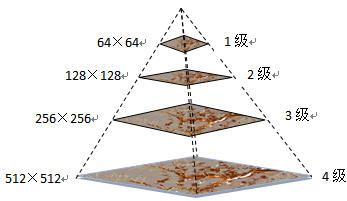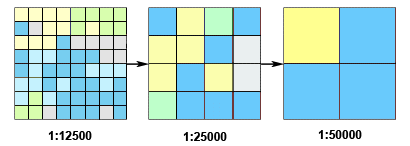An image pyramid is a collection of images generated according to specific rules, with resolutions ranging from fine to coarse. Image pyramid technology establishes a series of image layers at different resolutions through image resampling methods. Each layer is segmented and stored, and a corresponding spatial index mechanism is established, thereby improving display speed when zooming and browsing images. As shown in the figure below, the image pyramid at the bottom represents the original highest resolution of the image, with a resolution of 512×512. As you move upwards, the resolution decreases to 256×256, 128×128, and the top is the lowest resolution image of the pyramid at 64×64. Thus, this image pyramid has four layers, corresponding to four levels of resolution. Clearly, the higher the resolution of the image, the more levels the image pyramid has. For an image with a resolution of 2a×2b (where a > b), SuperMap will build a pyramid with (b - 6) + 1 layers.
 |
| Figure: Image Pyramid |
After an image pyramid is built for an image, the system retrieves its image pyramid to display data whenever the image is browsed. When you zoom in or out, the system automatically selects the most appropriate pyramid level based on the user's display scale to display the image.
Pyramids can only be created for original data. Pyramids can be built for only one dataset at a time. If you want to build them again, you need to delete the existing pyramid. When browsing a raster dataset after creating an image pyramid, you are actually accessing the created pyramid. The figure below illustrates the pyramid creation process at different scales.
 |
Creating an image pyramid can significantly improve the speed and performance of image zooming and display rendering. However, building an image pyramid also increases the storage space of the dataset, meaning it enlarges the size of the data source file where the image dataset resides. This is because the built image pyramid is essentially a collection of images at different resolutions, and these images at various resolutions are stored together with the data in the data source file, thus increasing its size. Moreover, the larger the data volume of the raster dataset, the longer it takes to build the pyramid, and the larger the storage space required for the image pyramid. However, it saves more time for future image browsing. Therefore, building pyramids is an efficient choice for optimizing massive image data.
The SuperMap SIT image file (obsolete) storage format is a data format that integrates image compression and efficient image pyramid technology. Thus, it can display image data extremely quickly, almost regardless of the image data size, and can smoothly display massive image data even on low-configuration machines.
Related Topics



